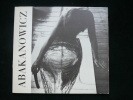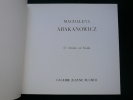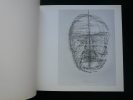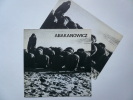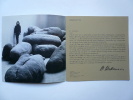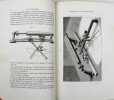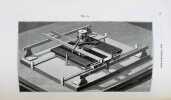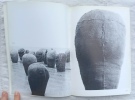13 books for « abakanowicz »Edit
-
Century
19th (2)
20th (5)
-
Topics
Architecture (1)
Avant-garde (1)
Dauphiné (1)
Exhibition (1)
Fine arts (3)
Industrial arts & crafts - fine arts (1)
Paris (1)
Photography (1)
Sculpture (2)
Technology (1)
Town planning (1)
-
Countries
Belgium (2)
Denmark (1)
France (8)
Switzerland (2)
-
Syndicate
ILAB (5)
SLAM (4)
Les Intégraphes. La Courbe Intégrale et ses Applications. [Bound together with C. Bohn: Über Linsenzusammenstellungen und Ihren Ersatz]. - [ABDANK-ABAKANOWICZ'S INTEGRAPH.]
Paris, Gauthier-Villars, 1886. Royal8vo. In contemporary half cloth with paper label pasted on to top of spine. Occassional brownspots throughout. With 94 figures in the text. X, 156 pp." (4), 88 pp. 20, 16, 15, 18, (31) advertising
First edition of Abakanowicz's famous integraph. It was invented independently about 1880 by the British physicist Sir Charles Vernon Boys and by Bruno Abakanowicz, however, the later being referred to as inventor (Goldstein, L'Europe mathématique: histoires, mythes, identities). ""The developments in the integraph design made by Abdank-Abakanowicz in France in the 1870s have been acknowledged as amongst the most noteworthy"" (Small, The Electronic Analogue Computer, P. 59).""The integraph is an elaboration and extension of the planimeter, an earlier, simpler instrument used to measure area. It is a mechanical instrument capable of deriving the integral curve corresponding to a given curve. Hence, it is able to solve elementary differential equations graphically. However, it was not until 1878 that he succeeded in developing a practical model. ""This volume is a description of the basic Abakanowicz instrument and a few of its later modifications. Abdank-Abakanowicz's instrument was able to produce solutions for only simpler differential equations, i.e., the commonly entountered class having the form dy/dx = F(x). An instrumental solution requires that as a first step a graph of the function F be drawn. Next, a pointer on the instrument is used to follow (trace) this graph. The value of the integral may then be read from the instrumentdials. This Abakanowicz approach was widely adopted in the early twentieth century, and the instrument was produced, and later improved, by such well-known instrument makers as Coradi in Zurich"" (The Erwin Tomash Library, Vol. 1, p. 2.).Bound with Abakanowicz's Integraph is:Répertoire Alphabétique des Procédés et Recettes publiés par Le Monde de la Science et de l'Industrie pendant les Années 1880 à 1886. Lausanne, Jaunin, 1887. 15 pp.Du régime de l'invention. Examen des améliorations proposées à la législation relative aux inventions à propos du nouveau projet de loi sur les brevets. Paris, A. Durand, 1862. 160 pp.Erwin Tomash Library A1.
Organic Structures.
Malmö Malmö Konsthall 1977 1 vol. broché in-4, broché, couverture en noir, 64 pp., nombreuses reproductions en noir. Texte en suédois et en anglais. Complet de la plaquette de présentation (volante). Très bon état.
Magdalena Abakanowicz : Textiles Strukturen und Konstruktion - Environments
Düsseldorf, Zentraldruckerei Wust & Co., 1972. In-4, non paginé, couverture originale illustrée (petits frottements).
Catalogue, en allemand, de l'exposition des sculptures et textiles de l'artiste polonaise Magdalena Abakanowicz, exposées du 29 mars au 28 mai 1972, au Kunstverein für die Rheinlande und Westfalen de Düsseldorf. Nombreuses reproductions en noir. * Membre du SLAM et de la LILA / ILAB Member. La librairie est ouverte du lundi au vendredi de 14h à 19h. Merci de nous prévenir avant de passer,certains de nos livres étant entreposés dans une réserve.
Abakanowicz, Galerie Alice Pauli, Lausanne, du 17 juin au 30 septembre 1981.
Lausanne, Galerie Alice Pauli 1981, 210x210mm, broché. Couverture à rabats. Bel exemplaire.
photos n/b, non paginé, Pour un paiement via PayPal, veuillez nous en faire la demande et nous vous enverrons une facture PayPal
Magdalena Abakanowicz 21 dessins au fusain.
Paris, Galerie Jeanne Bucher 1982, 180x200mm, broché. Bel exemplaire.
photos n/b, Pour un paiement via PayPal, veuillez nous en faire la demande et nous vous enverrons une facture PayPal
Les Intégraphes. La courbe intégrale et ses applications. Étude sur un nouveau système d'intégrateurs mécaniques
Paris, Gauthier-Villars, 1886, in-8, X-156 p, 94 fig. dans le texte, Broché, couverture imprimée de l'éditeur, Première édition. Les premiers intégraphes (ou intégrateurs mécaniques) qui permirent le tracé de la courbe intégrale furent inventés au début du XIXe siècle. Pendant les années 1875 à 1880, l'ingénieur mathématicien polonais Bruno Abdank-Abakanowicz (1852-1900) dota l'instrument d'une vis à pas variable et inventa un modèle d'intégraphe, dont il déposa le brevet en 1880. L'année suivante, l'inventeur s'installe en France. En collaboration avec l'ingénieur des chemins de fer David Napoli, il perfectionna son modèle avec des roues dentées, terminé en 1885, l'instrument sera commercialisé à Zurich par le constructeur suisse Oswald & Gottlieb Coradi. Cet ouvrage, rare, est la présentation des travaux de recherche qui ont abouti au modèle final de l'intégraphe le plus perfectionné de l'époque ainsi que la première étude documentée et illustrée encore jamais publiée sur la courbe intégrale. Dos passé. Couverture rigide
Bon X-156 p., 94 fig. dans le
MAGDALENA ABAKANOWICZ
Une plaquette de 8 pages, format 210 x 260 mm, illustré, broché, publié en 1993, bon état
Edité à l'occasion de l'exposition organisée au Musée Victor Charreton de Bourgoin-Jallieu (Isère) en novembre-décembre 1993
Phone number : 04 74 33 45 19
Magdalena Abakanowicz 21 dessins au fusain.
Paris, Galerie Jeanne Bucher, 1982, in-8 carré, broché, non paginé. Plaquette éditée à l'occasion de l'exposition du 12 janvier au 20 février 1982. Bon état.
NB. Les questions et commandes sont traitées dans les 24h. Les expéditions reprendront vers le 6 novembre. Merci.
Magdalena Abakanowicz. Galerie Alice Pauli, 17 juin au 30 septembre 1981.
Lausanne, Galerie Alice Pauli, 1981, 21x21cm, broché, np. (12p.) Bon état. Complet du carton d'invitation.
NB. Les questions et commandes sont traitées dans les 24h. Les expéditions reprendront vers le 6 novembre. Merci.
Les intégraphes - La courbe Intégrale et ses applications. Etude sur un nouveau système d'intégrateurs mécaniques.
Paris, Gauthier-Villars, 1886.
Première édition. Envoi autographe signé sur le faux-titre à Hippolyte Fontaine, industiel qui s'associera avec Zénobe Gramme, l'inventeur de la dynamo à courant continu. L'intégraphe est un instrument mécanique permettant de réaliser des intégrations de façon moins fastidieuse quen décomposant laire sous la courbe en une réunion de figures géométriques simples. Il utilise le principe de construction dune courbe dont la pente des tangentes est donnée. Couleur du dos passée, mais bon exemplaire. /// In-8 de X, 156 pp. Demi-chagrin vert, dos à nerfs orné (Reliure de l'époque.) //// First edition. Inscribed copy. "The integraph is a noteworthy development in the history of calculating instruments. While the principle on which it is based was introduced by Coriolis in 1836, it was in 1878 that Abdank-Abakanowitz first developed a practical working model. The integraph is an elaboration and extension of the planimeter, an earlier, simpler instrument used to measure area. It is a mechanical instrument capable of deriving the integral curve corresponding to a given curve. Hence, it is capable of solving graphically a simple differential equation. Sets of partial differential equations are commonly encountered in mathematical physics. Most branches of physics such as aerodynamics, electricity, acoustics, plasma physics, electron-physics and nuclear energy involve complex flows, motions and rates of change which maybe described mathematically by partial differential equations. A well-established example from electromagnetics is the set of partial differential equations known as Maxwell's equations. In practice, differential equations can be difficult to integrate, that is to solve. The integraph is capable of solving only simple differential equations. The need to handle sets of more complex non-linear differential equations, led Vannevar Bush to develop the Differential Analyzer at MIT in the early 1930s. In turn, limitations in speed, capacity and accuracy of the Bush Differential Analyzer provided the impetus for the development of the ENIAC during World War II. Abdank-Abakanowiczs instrument could produce solutions to a commonly encountered class of simple differential equations of the form dy/dx = F(x) so that y = ò F(x)dx. The basic approach was to draw a graph of the function F and then use the pointer on the device to trace the contour of the function. The value of the integral could then be read from the dials. The concept of the instrument was taken up and soon put into production by such well known instrument makers as the Swiss firm of Coradi in Zurich." /// PLUS DE PHOTOS SUR WWW.LATUDE.NET
DAVAL, Jean-Luc ; ABAKANOWICZ, Magdalena ; KOWALSKI, Piotr ; RAYNAUD, Jean-Pierre ; SONFIST, Alan ; VIATTE, Germain
Reference : 21612
(1992)
ISBN : 2605002322
Paris - La Défense. L’art Contemporain et l’Axe Historique
Skira - Etablissement Public pour l’Aménagement de la Région de la Défense (EPAD) 1992 In-4, pleine toile verte, sous jaquette illustrée, photographies en noir et en couleurs, 139 pp. Bon état d’occasion.
La présence de l’art dans la Défense est une vitrine de l'art contemporain, elle accueille des expositions, des concerts, des dîners-débat et de nombreux spectacles. Très bon état d’occasion
'Altérations'
Musée d'art moderne de la ville de Paris Broché In 4 (21 x 30 cm), broché, couverture souple illustrée, non paginé (environ 52 pages), cet ouvrage est composé de 21 reproductions en noir et blanc dont quelques unes en doubles pages, une préface de Suzanne Pagé, un texte de Jean-Luc Daval ainsi qu'une notice biographique, cet ouvrage est également enrichi d'une petite biographie de l'auteur sur une feuille volante, livre non daté (environ 1980) ; quelques pliures d'usage sur le dos et les mors de la couverture, intérieur frais, bel état général. Livraison a domicile (La Poste) ou en Mondial Relay sur simple demande.
"Altérations", Arc / Musée d'Art moderne de la Ville de Paris, non daté
21 cm X 29,8 cm, non paginé (58 pp), couverture souple et illustrée. Broché. Très grand nombre de photographies N&B.
Coins et bords frottés. Plats légèrement salis. Trace de pliure sur les bords. Bords insolés. Très bon état par ailleurs. Intérieur frais.
 Write to the booksellers
Write to the booksellers![Les Intégraphes. La Courbe Intégrale et ses Applications. [Bound together with C. Bohn: Über Linsenzusammenstellungen und Ihren Ersatz]. - ...](https://static.livre-rare-book.com/pictures/LLX/49270_1_thumb.jpg)
![Les Intégraphes. La Courbe Intégrale et ses Applications. [Bound together with C. Bohn: Über Linsenzusammenstellungen und Ihren Ersatz]. - ...](https://static.livre-rare-book.com/pictures/LLX/49270_2_thumb.jpg)


![Magdalena Abakanowicz : Textiles Strukturen und Konstruktion - Environments. [ABAKANOWICZ (Magdalena)]](https://static.livre-rare-book.com/pictures/TVX/21047_1_thumb.jpg)
![Magdalena Abakanowicz : Textiles Strukturen und Konstruktion - Environments. [ABAKANOWICZ (Magdalena)]](https://static.livre-rare-book.com/pictures/TVX/21047_2_thumb.jpg)
![Magdalena Abakanowicz : Textiles Strukturen und Konstruktion - Environments. [ABAKANOWICZ (Magdalena)]](https://static.livre-rare-book.com/pictures/TVX/21047_3_thumb.jpg)


